With the Imagining the Divine exhibition now open, Robert Bracey discusses the process of conveying messages through labels, and the particularly difficult example of the Bamiyan Buddhas.
“There is an inexpungeable relativity in every representation of historical phenomena. The relativity of the presentation is a function of the language used to describe and therefore constitute past events as possible objects of explanation and understanding.”
– Hayden White

About twenty years ago the trendy theory in historiography was postmodernism. If you read books about the theory of history, which is a sufficient limitation to make ‘trendy’ a doubtful adjective, then they were about postmodernism and filled with talk of tropes, performance, referents, the end of grand narratives, and the critique of historical truth. Today it is all rather out of fashion. In fact I listened to a recent LSE talk which wanted to blame a handful of French philosophers for Donald Trump.
That central critique of postmodern theory was that there was no necessary relationship between the stories we tell about the past, history, and what actually happened in the past. Though historians use sources these can be made to ‘speak’ in a variety of ways. And nothing exemplifies this better than the museum label.
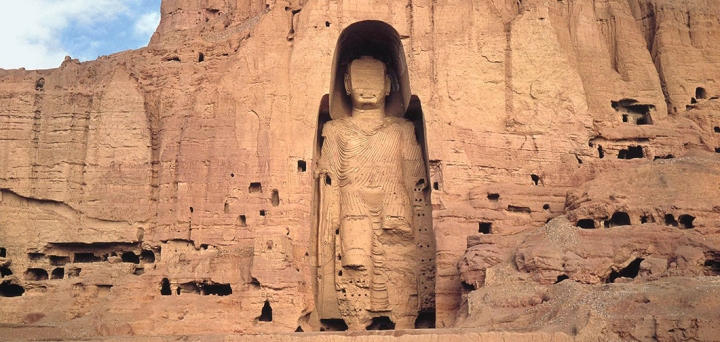
Let us take an example from the Imagining the Divine exhibition which opened a few days ago. The central room features a photograph of a rock-cut image of the Buddha from Afghanistan. That image, like most objects in modern exhibitions, is accompanied by a label a bit like this:
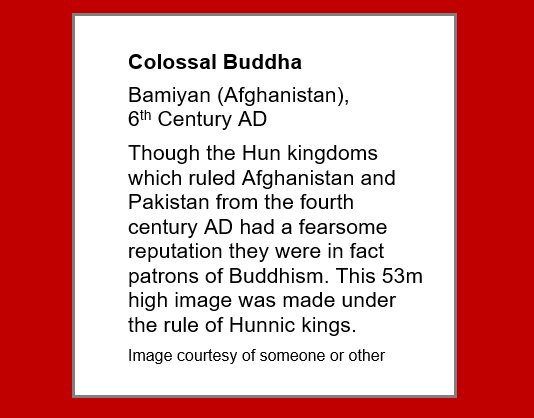
Okay, this is not the actual label we used, but it is a perfectly usable label. The story it contains is true, the Hunnic peoples who are often seen as destructive were in fact active patrons of Buddhism. Of course the term Hun is potentially confusing as an audience might think of Attila and not the Hephthalite/Alchon/Western Turk rulers referred to here; and in terms of ease of reading it is usually best to start with the object first and then context second, swapping the order of the sentences, but those are minor niggles. The real problem with this label is that the exhibition Imagining the Divine has nothing to do with Huns, it is about the development of religious iconography, so how about:
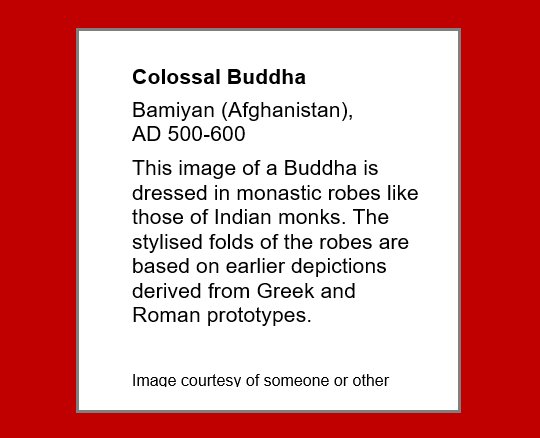
No, this is not the label from the exhibition either. And aside from the wording being a bit clumsy this is not really the story I would want to tell. Yes, it is true that Gandharan artists in the early centuries AD had a cosmopolitan outlook. Shortly before the Second World War French Archaeologists found a merchants store at Begram, just eighty miles from Bamiyan, which contained examples of Greek, Indian, and Chinese art. The artists of this region could, and did, draw on all of those various traditions when they made their first images of the Buddha. And while that story is in the exhibition it is not really the one I want to tell with a late object like the Bamiyan Buddha. Here we are nearing the end of the Buddhist section and want to say:
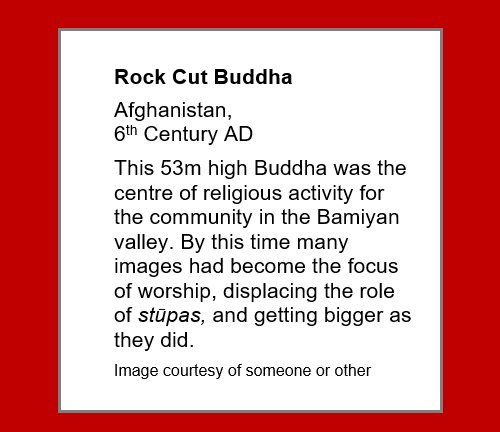
This is still not the label we used, but hopefully the point of that postmodern critique should be clearer by now. All of these are different stories, they frame the image in different ways, yet they are all ‘true’. Okay, the ‘getting bigger’ might be misleading; I’m not actually sure the Bamiyan image received worship; and not all images that became focuses of worship were colossal. But the trend is definitely that way – colossal images become more common as images move to the centre of worship. The point is that there are lots of true stories, and there is no compelling methodological reason why we should tell one rather than the other, why we slight the Huns, or Gandharan artists, in favour of how Buddhist religious practice changed – beyond our current interests.
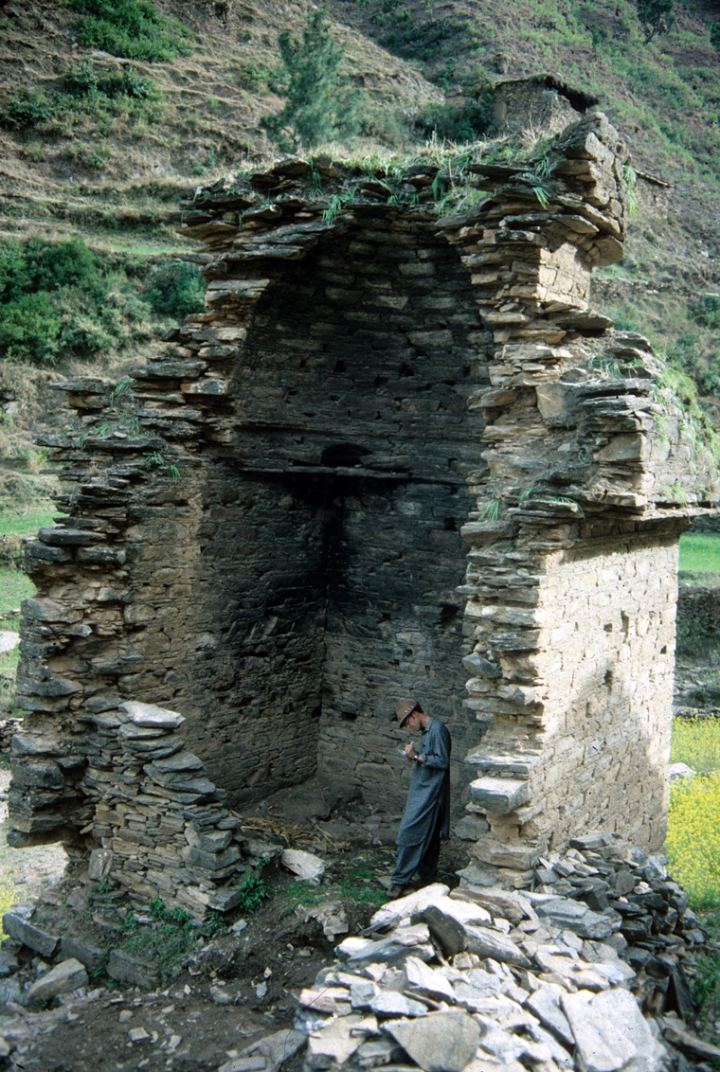
There is, of course, a reason why we would use an image of the Buddha at Bamiyan. This picture taken by Kurt Behrendt at the Metropolitan Museum shows the remains of an image shrine – with no image. There are a lot of these in Gandhara, where they were popular hundreds of years before the Bamiyan images were made – and they are almost all missing their images. The reason is simple, the images were made of a stucco that without constant maintenance would be destroyed by exposure to the elements. The Bamiyan image was also made using wood, stucco, and paint but over a core that was carved from the rock, and that core ensured its survival as one of the earliest examples from the general region discussed in the show. Which is why an image of Bamiyan needed to feature in the show and suggests another label:
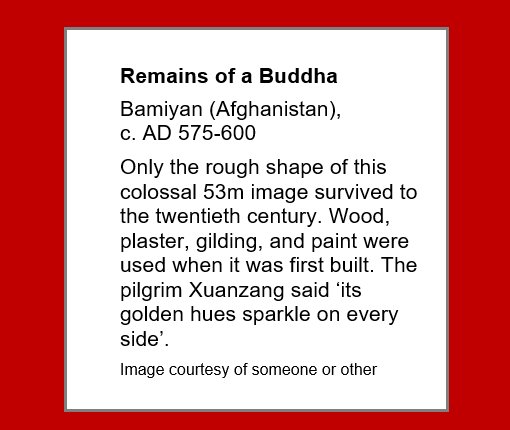
No, this was not the label we used either, and this one has a subtext. While it serves the useful task of telling the reader about the construction and original appearance of the image doing so also emphasises that the image, at least as Xuanzang experience it, does not survive. Hayden White wrote a whole book. Metahistory, about how important the sub-text, or as he called it the trope, the historian applied could radically change the readers understanding. In this case the reason that pointing out, entirely correctly, that this picture shows the badly damaged remains of an image, not a surviving one, creates a subtext is because of the label the lead curator, I, and our Islamic specialist agreed should not appear:
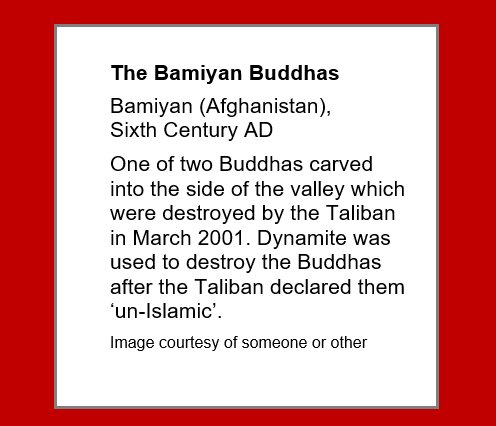
Were we just being ‘politically correct’? No, of course not. The Taliban destruction of the site, for which varying explanations have been given, happened a thousand years after the end of the chronological period covered by the show. It is hard to imagine a more methodologically unsound way to do history than to interpret the relevance or importance of a sixth century object to first millennium developments by what happened to it in 2001.
However, the postmodernists are right, power and politics shapes the stories you can tell. The exhibition explains how Buddhists initially made no images of the historical Buddha, his predecessors or successors, despite making figurative art for hundreds of years. When they did, around 100 AD, the representation of the Buddha came very rapidly to serve a central position in Buddhist practice. And so also began the ever increasing desire for larger, more dramatic, images. Many of the largest statues in the modern world are Buddhas, and they dwarf the mere 53m of Bamiyan. We needed to include Bamiyan, and we needed to acknowledge its destruction, the context of exhibition and the early twenty-first century would allow nothing else (power and politics).
If we omitted Bamiyan entirely the question would have been asked why such an obviously relevant piece of evidence had not been included. Yet because almost everyone knows at least one thing about Bamiyan, that the Buddhas were dramatically destroyed in 2001, you cannot tell the story of their construction without acknowledging they were destroyed. To do so would create a cognitive dissonance for any audience that would emphasise the destruction even more, especially since a re-organisation of the exhibition placed the display immediately next to the section on early Islam’s encounters with other cultures. It is in this sort of way that postmodernists claimed the ‘politics’ and ‘power’ of the modern world impinged on our historical reconstruction. But the story that matters, or at least that I think matters (from my very political, very modern, very personal position) is the story of how it was built, and what that meant. That it is one of the earliest colossal images to survive from one of the regions that first made images of the Buddha, makes it central to the story of Buddhism and how the community of Buddhists moved from one focused on the traces and absence of the Buddha to one focused on his image.
So what does the label in the exhibition say?
Well the honest answer is I do not know. No label had been installed when the curators and I went round on Wednesday. Due to various last-minute technical problems the original planned information could not get into the gallery it was still being sorted out. A label did get in that evening, and was about as bad as the label could be so hopefully came out the next morning, but I do not know which of the various texts I emailed on the coach on the way home actually made it to the wall.
A note on the date
The eagle-eyed will have noticed that I kept subtly altering the date in the mock labels in this post. In some cases I switched between ‘sixth century’ and ‘500 – 600’. Some interpretation departments hate the former, feeling it is harder for younger and second-language readers to follow. If you find ‘century’ in a label it tells you a lot about the audience the museum believes will read its labels. In one, and this is the same in the book accompanying the exhibition, I used ‘c. AD 575-600’. The honest answer is we do not really know but museum labels are a sort of performance. In this case they are performing the authoritative role of the museum as arbiter of ‘facts’ and repository of ‘expertise’.
The truth is that the date of the Bamiyan Buddha’s construction is not a ‘fact’ and I am not an ‘expert’. I’m not an expert on Gandharan art either, or the stupa at Amaravati. If I can claim a little more with regards to the red sandstone of Mathura that really reflects on the dearth of solid studies of that material. I do know Xuanzang visited the site, in about AD 634 according to the notes in most of the translations I have read, and that radio-carbon dates have been published indicating the late sixth century. And that basically fits my superficial knowledge of the development of colossal images, and the arguments Klimburg-Salter makes about when the valley was active. Though I do not know exactly what the C14 dates were taken from, how they were calibrated, and they can be pretty unreliable. And you will find much earlier dates than my ‘best guess’ quoted in much literature on the images.
I cannot say that in a gallery label, and not just because it is 240 words too long, but because the museum is making a performance out of its (and my) expertise. And there are only so many times you can undercut that with a question mark or an expression of uncertainty before people become uncomfortable, before the needs of the performance begin to outweigh any ‘truth’ that might exist in saying “I don’t know”.
Further Reading
Deborah Klimburg-Salter’s The Kingdom of Bamiyan, published in 1989, provides a scholarly account of the valley and its context in the political and artistic environment of the mid-first millennium AD. Articles about the destruction are commonplace and how, or if, it should feature in discussions of iconoclasm and Islam. I would recommend that by Barry Flood who has worked extensively on cultural interactions in this region. On postmodernism, at least on the postmodern critique of history, I always found Keith Jenkins Rethinking History the most readable, but be warned few of those involved ever thought of their task as clarity of communication.
===
Author: Robert Bracey
Photos: © Afghanistan Embassy and Robert Bracey

